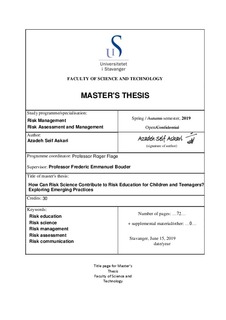| dc.contributor.advisor | Flage, Roger | |
| dc.contributor.advisor | Bouder, Emmanuel | |
| dc.contributor.author | Seif Askari, Azadeh | |
| dc.date.accessioned | 2019-11-03T09:32:59Z | |
| dc.date.available | 2019-11-03T09:32:59Z | |
| dc.date.issued | 2019-06-14 | |
| dc.identifier.uri | http://hdl.handle.net/11250/2626229 | |
| dc.description | Master's thesis in Risk management | nb_NO |
| dc.description.abstract | Risk education is an emerging and interdisciplinary topic. Children and teenagers need risk education to enhance their abilities for decision making under the complex and uncertain conditions of today’s world. Observations and performed practices have shown that various perspectives toward fundamental concepts of risk education resulted in a lack of a unified basis. The study aims to determine how risk science can contribute to risk education for creating a unified scientific basis. For this aim, the purpose is to know how the basic pillars of risk science are reflected in performed practices of risk education.
Participating at the international Risk Science and Decision Science for Children and Teenagers Conference in the Netherlands in 2018, Canada and the Netherlands were identified as the pioneers in performing practices of risk education. To gain more information, some relevant practices from some other countries were also examined. Semi open-ended interviews were conducted. Data were collected through interview responses as well as observations and discussions during the conference.
Results show that despite the fact that some fundamental concepts of risk science have been introduced to students in practices of risk education, they are not introduced or reflected sufficiently. While most of the practices in the Netherlands focus on fundamental concepts and technical risk assessment, they are not reflected in the practices of Canada or other countries. Moreover, in these practices, some of the basic pillars of risk science such as risk perception and risk communication have been neglected completely. Risk science can contribute to risk education by providing clear and systematic definitions and descriptions of fundamental risk concepts. Moreover, it clarifies the limitations of quantitative risk assessment by reflecting the principles of risk perception. Hence, risk education will be capable of improving children’s and teenagers’ abilities to have better communication skills and to have an active role in their society. | nb_NO |
| dc.language.iso | eng | nb_NO |
| dc.publisher | University of Stavanger, Norway | nb_NO |
| dc.relation.ispartofseries | Masteroppgave/UIS-TN-ISØP/2019; | |
| dc.subject | risk management | nb_NO |
| dc.subject | risk education | nb_NO |
| dc.subject | risikostyring | nb_NO |
| dc.subject | risk science | nb_NO |
| dc.subject | risk assessment | nb_NO |
| dc.subject | risk communication | nb_NO |
| dc.title | How Can Risk Science Contribute to Risk Education for Children and Teenagers? Exploring Emerging Practices | nb_NO |
| dc.type | Master thesis | nb_NO |
| dc.subject.nsi | VDP::Social science: 200 | nb_NO |
| dc.subject.nsi | VDP::Technology: 500 | nb_NO |
